


Steepest Cogwheel Railway in the World !
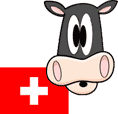 Alpnachstad, Switzerland, the base station for the Pilatus Bahn (PB) lies on Die Zentralbahn (ZB) route between Luzern and Interlaken. Arriving at the Zentralbahn platform it is but a short walk to a plaza containing the PB ticket office, base station, and a cafe. The Pilatusbahn is the steepest rack railway in the world with its maximum gradient of 48 percent ! The line runs from the base station to a terminus near the Esel summit of Mount Pilatus at an elevation of 2,073 metres (6,801 feet), which makes it the highest railway in the canton of Obwalden and the second highest in Central Switzerland after the Furka line. The Jungfraubahn would be the highest with their summit station located inside a mountain at 3,454 metres (11,332 feet).
Alpnachstad, Switzerland, the base station for the Pilatus Bahn (PB) lies on Die Zentralbahn (ZB) route between Luzern and Interlaken. Arriving at the Zentralbahn platform it is but a short walk to a plaza containing the PB ticket office, base station, and a cafe. The Pilatusbahn is the steepest rack railway in the world with its maximum gradient of 48 percent ! The line runs from the base station to a terminus near the Esel summit of Mount Pilatus at an elevation of 2,073 metres (6,801 feet), which makes it the highest railway in the canton of Obwalden and the second highest in Central Switzerland after the Furka line. The Jungfraubahn would be the highest with their summit station located inside a mountain at 3,454 metres (11,332 feet).
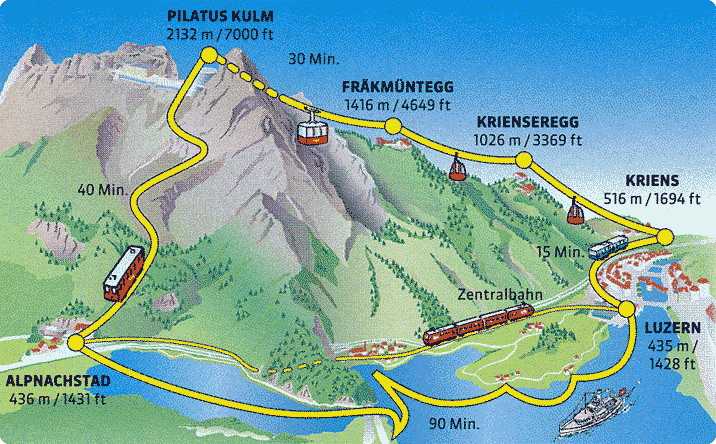
 The railway was constructed beginning in 1888 and completed in 400 workdays with the help of 600 workers. It opened for passengers on 4 Jun 1889 with eight steam powered carriages. The middle station, known as Aemsigen, was where the steam cars would fill up with water. Each car consumed 800 litres of water and 350 kilograms of coal for just one uphill climb.
The railway was constructed beginning in 1888 and completed in 400 workdays with the help of 600 workers. It opened for passengers on 4 Jun 1889 with eight steam powered carriages. The middle station, known as Aemsigen, was where the steam cars would fill up with water. Each car consumed 800 litres of water and 350 kilograms of coal for just one uphill climb.
The 800 millimetre (2 foot 7 1/2 inch) gauge track to the summit is 4,618 metres (15,151 feet) in length and contains no ballast. Rails and the rack section are bolted to the rock. The speed of carriages is limited between 7-12 kilometres per hour while travelling uphill and reduced to just 6-9 kilometres per hour when running downhill. The uphill climb takes approximately 30 minutes while going down takes 40 minutes.
On 15 May 1937 steam power was replaced by electric power of 1,550 volts DC received through overhead catenary. The electric cars were constructed by Schweizerische Lokomotiv und Maschinenfabrik (SLM) in Winterthur. You'll notice in the photos that cars are not connected to the catenary when travelling downhill. This is because each car's motor generator is used to brake the car during descent but the electricity generated is not returned to the wire. It is dissipated as heat through resistance grids. Each car provides 210 horsepower to carry about 40 passengers.
Because the railway uses the Locher rack system it's not possible to use conventional railway switches on the line. The horizontal Locher pinions, or cog wheels, have a lip located below the teeth that engage the rack. This prevents the cogs from disengaging from the rack thereby enabling steep gradients up to 48 percent. A typical rack system, with vertical mounted cog wheels, might slip and disengage on such steep grades with catastrophic results. Since Locher cogs can't disengage the use of typical railway switches with their frogs and points just won't work. Instead, transfer tables and special rotary switches are used where a branch is required.
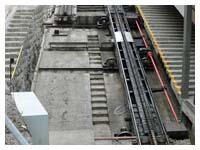
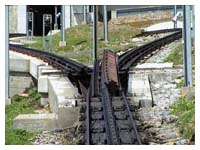
 The Pilatusbahn has a new logo, one that symbolizes the rich world of sagas around Pilatus Mountain. Almost every mountain in Switzerland has a mountain railway, but only Mount Pilatus has dragon legends. Here are a few legends about the Mount Pilatus dragon:
The Pilatusbahn has a new logo, one that symbolizes the rich world of sagas around Pilatus Mountain. Almost every mountain in Switzerland has a mountain railway, but only Mount Pilatus has dragon legends. Here are a few legends about the Mount Pilatus dragon:
In the summer of 1421, an enormous dragon was flying to Mount Pilatus when it crashed close to a farmer named Stempflin who fainted from the shock. When he recovered, he found a clot of blood containing a dragon stone. The stone's healing powers were officially confirmed in 1509.
One autumn, a young man fell into a deep cave on Pilatus and landed between two dragons. They did not hurt him. When spring came, one of the dragons left its winter home and flew away. The second one told the young man that it was time to leave. The dragon moved to the opening, held out its tail to the young man and rescued him from the cave.
"Fractus mons", the broken mountain, was the name of the mountain above Luzern before the story of Pontius Pilate. (You may recall this dude from the story of Jesus Christ.) His final resting place, according to legend, is on top of Mount Pilatus, which was named after him. And even after the soul of Pilatus was pacified, it remains a mysterious mountain, a mountain with views and sights, of earthly beauty, and underground creatures, particularly at night, dark and cloud-covered above the city.
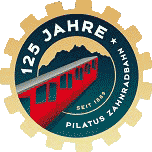 17 May 2015 is overcast, again, but warm along the Die Zentralbahn route to Alpnachstad. Upon arrival at the platform a large dragon logo is visible on the granite face above the Pilatusbahn base station. Several buildings surround a pedestrian only plaza including the base station, a separate ticket office, and a cafe. One immediately notices a Pilatusbahn car on a steep incline. The car's windows are terraced, like steps, there's no way this vehicle would ever run on a horizontal rail line. There's a short line of people purchasing tickets. With about a 20 minute wait until the next departure there's time to photograph the structures around the plaza.
17 May 2015 is overcast, again, but warm along the Die Zentralbahn route to Alpnachstad. Upon arrival at the platform a large dragon logo is visible on the granite face above the Pilatusbahn base station. Several buildings surround a pedestrian only plaza including the base station, a separate ticket office, and a cafe. One immediately notices a Pilatusbahn car on a steep incline. The car's windows are terraced, like steps, there's no way this vehicle would ever run on a horizontal rail line. There's a short line of people purchasing tickets. With about a 20 minute wait until the next departure there's time to photograph the structures around the plaza.
Nearing departure time a group of passengers form in the open area of the station to wait for a "down" car to arrive and empty its load. A car arrives and empties so the group climbs the stairs and enters the five compartments. Seats are unpadded, tough people these Swiss, so you might want to bring a cushion for the 40 minute trip. Or, on the other hand, you can stand up every now and then to take photos thereby relieving your tushy.
The car climbs slowly through forest stopping at a passing siding, Aemsigen, where the old steam powered cars would take water, now redundant with the use of electric powered vehicles. Transfer table type switches slide left and right to permit the passing of cars, generally two at a time, two up, two down. Each single car runs independently along the line and is not coupled to any another.![]()
After a siding meet the forest starts to give way to grass and barren rock. The grade varies, 30%, 40%, and 48%. After passing through a tunnel it's bare rock, moss, and patches of snow to the top where a large hotel lies just beneath the summit. The upper terminus is an ominous dull concrete grey structure nestled against a huge rock face. The car enters one of two black portals into the depot. The darkness envelopes the car as it stops. Passengers unload into a dimly lit tunnel with concrete steps leading upwards. Wandering about the first level one finds large glass doors that empty out onto a broad patio with views of the summit above, and tracks leading down into the valley below. Climbing steps above the complex gives an overall view of the round Hotel Bellevue, Pilatusbahn depot, and the new cable car terminal with cables leading down the opposite side of the mountain. Concrete structures all, how DID they get all that concrete up here? No matter, lunch is a nice buffet in the Hotel Bellevue restaurant, to be followed by a trip back down the line. Now if I could just find my umbrella... maybe I left it in the restaurant?
10 Jun 1949 - Straight Up
23 Jun 2011 - Here Be Dragons
5 Jan 2014 - Special Stamp for Pilatusbahn
25 May 2014 - Acrophobia on the Steepest Cogwheel Railway in the World
4 Jun 2014 - Exactly 125 Years Ago the First Cog Railway Ran on the Pilatus
Pilatusbahn (PB)
Video 2013 Pilatusbahn
Video 1937 Electrification of Pilatusbahn Part 1
Video 1937 Electrification of Pilatusbahn Part 2
BRB downloadable wallpaper
Die Zentralbahn
ASME Historic Mechanical Engineering Landmark


